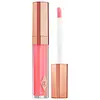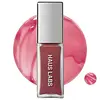Charlotte Tilbury Lip Lustre Lip Gloss Versus Haus Labs By Lady Gaga PhD Hybrid Lip Glaze Plumping Gloss
What's inside
What's inside
 Key Ingredients
Key Ingredients

 Benefits
Benefits

No benefits
 Concerns
Concerns

 Ingredients Side-by-side
Ingredients Side-by-side

Polybutene
Isocetyl Stearate
EmollientTrimethylolpropane Triisostearate
EmollientDiisostearyl Malate
EmollientSilica Dimethyl Silylate
EmollientPropylparaben
PreservativeMica
Cosmetic ColorantPropylene Glycol Dicaprylate/Dicaprate
EmollientAroma
BHT
AntioxidantNelumbo Nucifera Flower Extract
Skin ConditioningDicalcium Phosphate
AbrasiveSilica
AbrasiveCalcium Sodium Borosilicate
Tin Oxide
AbrasiveCI 77891
Cosmetic ColorantIron Oxides
CI 15850
Cosmetic ColorantCI 45380
Cosmetic ColorantCI 45410
Cosmetic ColorantCI 73360
Cosmetic ColorantCI 19140
Cosmetic ColorantCI 15985
Cosmetic ColorantCI 42090
Cosmetic ColorantPolybutene, Isocetyl Stearate, Trimethylolpropane Triisostearate, Diisostearyl Malate, Silica Dimethyl Silylate, Propylparaben, Mica, Propylene Glycol Dicaprylate/Dicaprate, Aroma, BHT, Nelumbo Nucifera Flower Extract, Dicalcium Phosphate, Silica, Calcium Sodium Borosilicate, Tin Oxide, CI 77891, Iron Oxides, CI 15850, CI 45380, CI 45410, CI 73360, CI 19140, CI 15985, CI 42090
Polybutene
Triisostearoyl Polyglyceryl-3 Dimer Dilinoleate
EmollientDiisostearyl Malate
EmollientOctyldodecanol
EmollientPolyglyceryl-2 Triisostearate
EmulsifyingC18-38 Alkyl Hydroxystearoyl Stearate
EmollientSilica
AbrasiveOpuntia Ficus-Indica Seed Oil
EmollientPalmitoyl Tripeptide-37
Skin ConditioningPalmitoyl Tripeptide-1
Skin ConditioningPalmitoyl Tripeptide-38
Skin ConditioningPortulaca Pilosa Extract
Skin ConditioningSqualane
EmollientEthylhexyl Palmitate
EmollientTribehenin
EmollientTocopherol
AntioxidantSucrose Cocoate
EmulsifyingTriethoxycaprylylsilane
Galactoarabinan
Caprylyl Glycol
EmollientCetearyl Ethylhexanoate
EmollientGlycerin
HumectantMalic Acid
BufferingLactic Acid
BufferingSorbitan Isostearate
EmulsifyingIsostearyl Alcohol
EmollientHexylene Glycol
EmulsifyingEthyl Vanillin
MaskingWater
Skin ConditioningIsostearic Acid
CleansingEthylhexylglycerin
Skin ConditioningSodium Sulfate
Phenoxyethanol
PreservativeCI 77491
Cosmetic ColorantCI 77891
Cosmetic ColorantCI 15850
Cosmetic ColorantCI 19140
Cosmetic ColorantPolybutene, Triisostearoyl Polyglyceryl-3 Dimer Dilinoleate, Diisostearyl Malate, Octyldodecanol, Polyglyceryl-2 Triisostearate, C18-38 Alkyl Hydroxystearoyl Stearate, Silica, Opuntia Ficus-Indica Seed Oil, Palmitoyl Tripeptide-37, Palmitoyl Tripeptide-1, Palmitoyl Tripeptide-38, Portulaca Pilosa Extract, Squalane, Ethylhexyl Palmitate, Tribehenin, Tocopherol, Sucrose Cocoate, Triethoxycaprylylsilane, Galactoarabinan, Caprylyl Glycol, Cetearyl Ethylhexanoate, Glycerin, Malic Acid, Lactic Acid, Sorbitan Isostearate, Isostearyl Alcohol, Hexylene Glycol, Ethyl Vanillin, Water, Isostearic Acid, Ethylhexylglycerin, Sodium Sulfate, Phenoxyethanol, CI 77491, CI 77891, CI 15850, CI 19140
Ingredients Explained
These ingredients are found in both products.
Ingredients higher up in an ingredient list are typically present in a larger amount.
Ci 15850 is the pigment color red. It is an azo dye and created synthetically.
Azo dyes need to be thoroughly purified before use. This allows them to be more stable and longer-lasting.
This ingredient is common in foundations, lipsticks, and blushes. This color is described as brown/orangey red.
It has many secondary names such as Red 6 and Red 7. According to a manufacturer, Red 6 usually contains aluminum.
Learn more about CI 15850CI 19140 is also known as Tartrazine. Tartrazine is a synthetic dye used in cosmetics, foods, and medicine to add a yellow color.
Tartrazine is created from petroleum and is water-soluble.
Some people may experience allergies from this dye, especially asthmatics and those with an aspirin intolerance.
Learn more about CI 19140Ci 77891 is a white pigment from Titanium dioxide. It is naturally found in minerals such as rutile and ilmenite.
It's main function is to add a white color to cosmetics. It can also be mixed with other colors to create different shades.
Ci 77891 is commonly found in sunscreens due to its ability to block UV rays.
Learn more about CI 77891Diisostearyl Malate is an emollient and most often used in lip products. It comes from isostearyl alcohol, a fatty acid, and malic acid, an AHA.
As an emollient, Diisostearyl Malate helps create a thin film on your skin to trap moisture in. This helps keep your skin soft and smooth.
Polybutene is used to help control the viscosity of a product. This just means it helps adjusts the texture.
It is a polymer and does not get absorbed into the skin due to its large size.
Studies found this ingredient did not irritate skin in concentrations below 15%.
Learn more about PolybuteneSilica, also known as silicon dioxide, is a naturally occurring mineral. It is used as a fine, spherical, and porous powder in cosmetics.
Though it has exfoliant properties, the function of silica varies depending on the product.
The unique structure of silica enhances the spreadability and adds smoothness, making it a great texture enhancer.
It is also used as an active carrier, emulsifier, and mattifier due to its ability to absorb excess oil.
In some products, tiny microneedles called spicules are made from silica or hydrolyzed sponge. When you rub them in, they lightly polish away dead skin layers and enhance the penetration of active ingredients.
Learn more about Silica